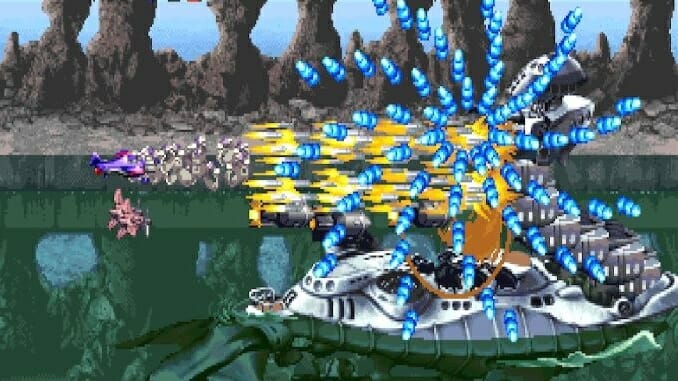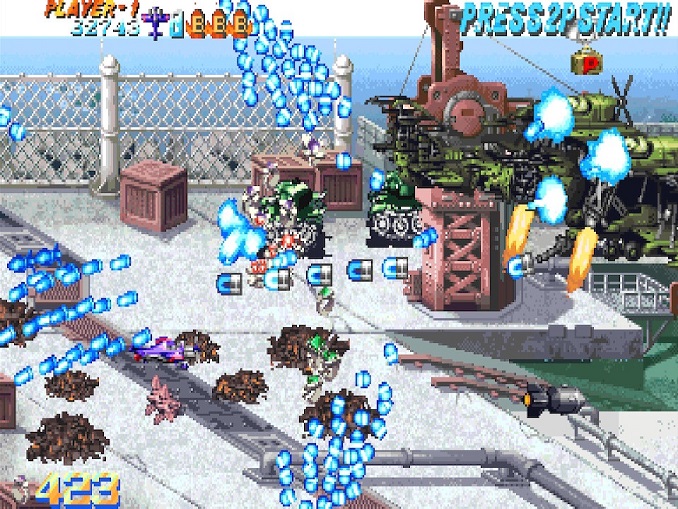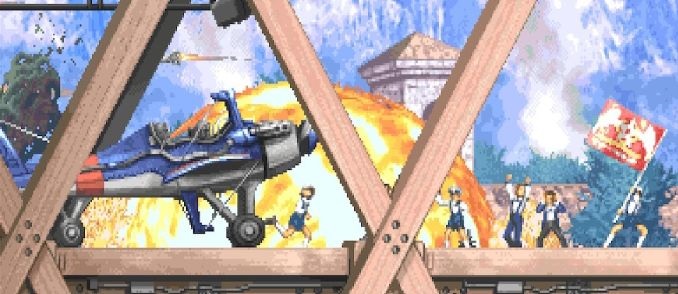Progear Is a Steampunk Dive into the Depths of Bullet Hell
The Shmuptake #3: What We Talk About When We Talk About Bullet Hell
Games Features shmups
Welcome to The Shmuptake, an occasional column about the history of the shoot ‘em up, aka the “shmup.” Here’s an introduction.
“Bullet hell” means something specific. You can’t just slap the term on every shoot ’em up that gives you trouble. Bullet hell shooters bury you beneath sheets of bullets, with intricate patterns of projectiles swarming the screen and forcing you to maneuver with delicate precision. They’re not just about dodging bullets while firing your own; you can’t just rely on reflexes, but have to commit all these various bullet patterns to memory. You know those scenes in heist movies when somebody who is entirely too flexible has to carefully step over and duck under the crisscrossing lasers of some elaborate alarm system? Bullet hell games are like that, stretched out for however long the game lasts. And yes, it’s as stressful as it sounds.
CAVE, a studio based in Tokyo, is the master of the bullet hell. The developers of games like the DoDonPachi series, Deathsmiles and Akai Katana, CAVE has probably put more bullets on TV screens than any other company in the world. When gaming giant Capcom wanted to release an exceptionally hard shmup for arcades in 2001, they turned to CAVE. The result was Progear, a game that broke ground for CAVE while also breaking the spirit and bank of anybody who ever dared to slide a coin into it.
Progear was CAVE’s first side-scrolling shooter, and it’s basically a sea of bullets that you have to delicately sail your plane through. Tanks, planes, and cannons constantly spit bullets at you, and bosses clog up the screen with endless streams of projectiles. If you can’t fly around them your only options are to die or launch a bomb; when that bomb hits a target, it briefly creates a cloud of flame, which destroys any bullets or enemies that touch it. Of course bombs are limited, and Progear’s unique scoring system punishes you for both using a bomb and dying, lowering your possible score whenever either happens.

Fortunately the hitbox for your plane is slightly forgiving. You don’t have to perfectly thread the needle of every clutch of bullets coming your way; if it merely grazes the bottom of your plane, you’ll probably escape unharmed. A direct hit is fatal, and you will collect direct hits like they’re your favorite thing in the world, but the fuzziness of the hitbox will often save you from seemingly hopeless situations. Also, as with many arcade games, you can continue from the exact spot where you died, with whatever damage you inflicted upon your enemies persisting; if you can afford to keep pumping in coins (or, if, like me, you’re playing on a console or computer at home), you’ll be able to continue every time you die, which ultimately makes the game not that punitive despite its extreme difficulty. If you’re a puritan who needs to finish on a single coin, you’ll have countless hours (weeks, months, years?) of practice ahead of you. If you simply want to see the game’s story play out, you can do so the very first time you play it, assuming you’re cool with endlessly continuing after death.
If you’re wondering who would care about a shmup’s story, well, Progear is notable in that it actually has a fairly interesting one. Or maybe, instead of “story,” I should just say “setting.” It’s seemingly set in an early 20th century European country where every adult is an obscene, murderous oligarch hellbent on tyranny, and every teenager is a daring freedom fighter behind the wheel of an old-timey airplane. Steampunk before steampunk quickly wore out its welcome, Progear is full of beautifully designed flying ships and gorgeous backdrops. Each boss gets a brief introduction, revealing their name, a nickname, and giving a brief glimpse at their personal style and comportment; these quick intros pack a surprising amount of character information into blink-and-you’ll-miss-them vignettes, turning the boss battles from anonymous shootouts into something with a bit of personality to them.

Writing almost 700 words before even touching on Progear’s peculiar mechanics might seem like burying the lede a bit, but the direct route is almost never the best option in this game. What really sets Progear apart from other shmups, including CAVE’s previous games, is the unique nature of its combat system. When the game starts you pick between one of two pilots; one is a little faster, with a more focused gun, while the other is slower with a wider spray. You also pick one of three gunners, who are responsible for your plane’s secondary fire; one gunner fires out homing missiles, another deals out slightly stronger missiles that don’t lock onto targets, and the third launches a spray of cannonballs. This basically gives you six different combat profiles, and you should mix and match until you find what works best for you. There’s still more going on with the combat here, though. You can hold the fire button down, and both your pilot and gunner will shoot out a constant stream of fire. It’s a tight, focused spray that does less damage than when you manually fire; it also makes your plane move considerably slower as long as you’re holding the button down. You’ll move faster, cover a larger amount of territory with your bullets, and do more damage if you skip autofire and press the fire button repeatedly. And although there are power-ups that will increase the power of both of your weapons, you won’t pick up satellite ships or new kinds of firepower during the game—what you start with is all you’ll get. Progear has a complex shooting system that gives you a lot of flexibility in how you play, and then puts you in situations that incentivize you to switch from autofire to manual or vice versa. That variety, combined with the short length of most levels, keeps Progear from ever feeling too repetitive. Even if you continue through to the end on your first play, you’ll still have multiple other combinations of pilot and gunner to experiment with on future runs.
Progear isn’t young; it turns 20 this year, which might as well be 100 when it comes to videogames. Still, 2001 was a late date for the shmup as a genre. Once one of the central genres in the business, the shoot ’em up felt as outdated as the arcade by the 21st century. Progear was popular in Japan, where arcade culture persisted longer than most other countries, but it’s still largely obscure in America, celebrated by shmup fans but unknown outside of our fellow cultists. It’s maybe a little too difficult to have ever made a mainstream impact over here, and lacks the kind of gimmicky power-ups and weapons that many expect from a shmup, but if you take the time to explore it there’s a good chance you’ll like what you see. You can find it in the Capcom Arcade Stadium collection that was released earlier this year; if you’re at all a fan of old games and the arcade era, you’ll find a lot to enjoy in that collection.
Progear
Year: 2001
Developer: CAVE
Publisher: Capcom
Original Platform: Arcades
Platform We Played It On: Switch, in the Capcom Arcade Stadium collection
Also Available On: The Capcom Arcade Stadium has also been released for the PlayStation 4, Xbox One, and PC
Senior editor Garrett Martin writes about videogames, comedy, travel, theme parks, wrestling, and anything else that gets in his way. He’s also on Twitter @grmartin.